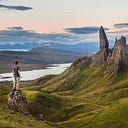UE4 Interface Overview
Creating Immersive Worlds
So you’ve downloaded and installed Unreal Engine. That is 50% of the work (well…the time if you are on a low-bandwidth connection)
Here’s what the UE4 Launcher looks like for me (notice all of the project names…MyProject, MyProject1, MyProject3 — this is typical and not a best practice but it is something I am guilty of).
Go ahead and launch the editor.
The two main tabs, Projects and New Project are self-explanatory (Projects can also be opened from the Launcher itself).
The New Project tab contains a few options to get you bootstrapped. We’re only going to focus on Blueprint projects for now.
Once the engine finishes loading your project, you’ll see the main engine view:
When the editor opens, you’ll see the main editor window. It’s the main interface we’ll be working in. This is your gateway to the world of VR development in UE4 (really any type of game development in UE4).
The Viewport
This is our level editing window, gives us a view into our 3D worlds and where we’ll be doing most of our level construction. I’ll cover the viewport in a lot of detail throughout the first few videos, so no worries if it looks like a lot to take in. Here’s a video (or skip and read on):
Menu Bar
Standard menu.
- File — allows us to do things like save our level, create a new one, and, most importantly, to package our project for a variety of devices and platforms. For this course, we are sticking to PC VR, but it’s not too much more work to build to mobile VR devices, depending on the complexity of the geometry, lighting and interactions in your experience.
- Edit — this is also fairly standard, with the exception that some key configuration menus are here. We already took a look at the project settings menu in some detail when we were setting up our project. There are also options here to configure how the editor looks, as well as to enable plugins, such as Steam Audio, we’ll be experimenting with in a later video series on spatial audio and sound synthesis.
- Window — here you can open and close various windows. I like to make sure that World Settings and Levels are open. There are also times when we will look at stats and some developer tools like the Output log. If you accidentally close a window, you can go here and get it back.
- Help — This is where you will find a variety of…help. It’s surprisingly helpful, especially the documentation.
Modes
The modes panel These change the primary behavior of the Level Editor for a specialized task, such as placing new assets into the world, creating geometry brushes and volumes, painting on meshes, generating foliage, and sculpting landscapes.
By default, placement mode, which is how we place objects, or actors, in our scene
Paint mode — this mode allows you to paint on to 3D objects, or meshes in the level viewport.
Landscape — this mode allows you to create and sculpt large outdoor terrain
Foliage — the foliage mode lets you paint on foliage, such as grass, or leaves.
Geometry Editing — this mode allows you edit geometry. Back in the early days of 3D game engines, geometry brushes were the primary building blocks in level design. Today, that job is mostly taken up by static meshes, which are far more efficient.
Toolbar
Common tasks, saving, blueprints, the lighting build button and the all-important PLAY button. We’ll be using both of these quite a bit throughout the course.
Settings Button
Something else that is worth mentioning is the settings menu. Specifically, there are options for scalability. These settings can be helpful if your computer is running the editor at a very low frame rate. To check this, we can click on the viewport options button and choose to Show FPS, or frames-per-second.
In addition, you can choose to have realtime audio previewing, which will come in handy when we’re doing the sound design for our experience.
Content Browser
NOTE: I recommend showing the sources panel, it speeds up browsing!
This is a very important panel, and it’s the primary way for you to access and create content, materials, static meshes, stuff you’ve created in other software. Because we included starter content, we already have some things in here. It’s pretty simple to add things to your scene, you can drag-and-drop things into your scene.
Right-clicking will let you create a new asset, for example, a material, and also
The content browser also lets you access the sub-editors associated with certain assets in your project.
World Outliner
The World Outliner is a list of all of the elements you have in your scene.
You can double-click on any one of them and find it in your scene
I also like to use it to organize certain types of objects in my scene, for example, lights, or static meshes.
Details Panel
The details panel is very important. It controls the properties for any object in your scene. For example, we see the position of the object in the world in X,Y,Z space, we also see object-specific details — since we have a Sound Cue selected, we can see and set the sound-specific details

